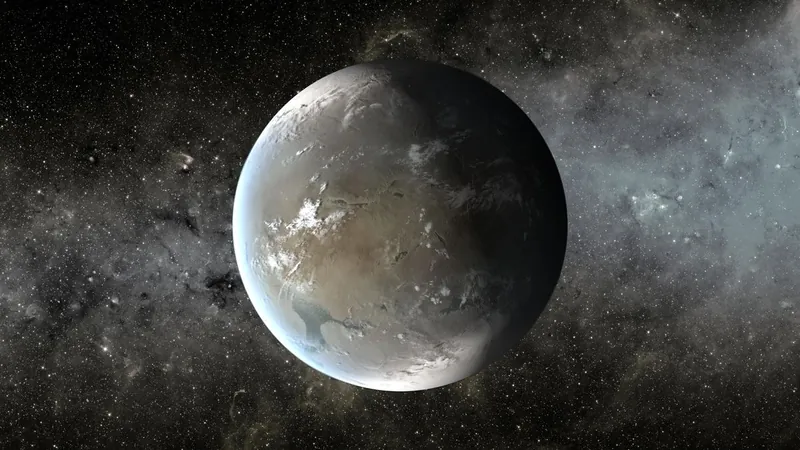
Discovery Alert! Newly Identified Super-Earth TOI-512b May Have Shed Its Own Atmosphere!
2025-03-31
Author: John Tan
Introduction
In an exciting breakthrough for planetary science, astronomers have discovered a new super-Earth that may provide clues to the puzzling absence of many exoplanets in the universe. Identified by NASA's Transiting Exoplanet Survey Satellite (TESS) alongside the ESPRESSO instrument at the Very Large Telescope in Chile, the planet named TOI-512b has piqued interest across the scientific community.
Significance of Discovery
Lead researcher Jos é Rodrigues from the Porto Institute of Astrophysics remarked, "This may seem like just another addition to the catalog of known planets, but each discovery is vital. They enhance our knowledge of how planets are formed and evolve." With ongoing explorations, the hope is that such findings can transition from hypothesis to concrete scientific understanding.
Details about TOI-512b
TOI-512b is situated approximately 218 light-years from Earth and was initially spotted by TESS back in 2020 when it transited in front of its host star, momentarily blocking its light. Detailed observations allowed astronomers to deduce that this exoplanet boasts a radius about 1.54 times that of Earth.
Mass and Density Analysis
To decisively confirm TOI-512b's existence, the ESPRESSO instrument measured the star's radial velocity, which revealed a "wobble" corresponding to the gravitational pull of the planet. This analysis unveiled TOI-512b's mass as approximately 3.57 times that of our planet, leading to a calculated bulk density of 5.62 grams per cubic centimeter—marginally denser than Earth.
Atmospheric Loss and Composition
Astounding as it may be, given that TOI-512b is not just larger but also heavier than Earth, the determining factors about its composition are more intricate. With its rapid orbit lasting just 7.1 days and a proximity to its star that places it outside the habitable zone, the exoplanet experiences intense heat—receiving 112 times more stellar energy than Earth.
The Hot Neptune Desert
One of the prominent mysteries surrounding exoplanets relates to the "hot Neptune desert," a term used to denote the unusual scarcity of planets that fall between 1.8 and 2.4 times the radius of Earth. The prevailing theories suggest that such Neptune-like worlds lose their gaseous atmospheres due to stellar radiation or internal heat escaping from their cores, leading to the formation of smaller, rockier planets.
Potential Atmospheric Loss Mechanism
TOI-512b could provide a fascinating case study, as it may have undergone significant atmospheric loss to become what it is today. Rodrigues’ team posited a model of TOI-512b’s internal structure, suggesting it could have a core comprising 13% of its mass, with a mantle accounting for 69% and a significant water layer equaling up to 16%. This is drastically more than Earth, which contains a mere 0.02% of its mass in water.
Age and Mass Loss Concerns
The findings propose that the mass loss TOI-512b has experienced leans towards the core-powered mechanism rather than total atmospheric loss due to stellar radiation, potentially influenced by its age of over 8 billion years—indicating that this process might persist for substantial periods.
Variation in Atmospheric Loss
However, the study also indicated that not all planets that traverse the hot Neptune desert lose their atmospheres uniformly; different factors including stellar radiation could play varying roles depending on the specific planetary system.
Further Research Needed
The research also dismissed a second candidate planet once speculated in earlier TESS data, emphasizing the need for more comprehensive studies to solidify current hypotheses. Although the James Webb Space Telescope’s capacity for transit spectroscopy might be limited for this particular planet due to its distance, there is hope that the anticipated 39-meter Extremely Large Telescope with the ANDES spectrometer may yield fruitful results in the future.
Conclusion
As astronomers continue to unlock the secrets of the cosmos, discoveries like TOI-512b remind us of the endless wonders and mysteries waiting to be explored in the vast universe. Stay tuned for more exciting updates!



 Brasil (PT)
Brasil (PT)
 Canada (EN)
Canada (EN)
 Chile (ES)
Chile (ES)
 Česko (CS)
Česko (CS)
 대한민국 (KO)
대한민국 (KO)
 España (ES)
España (ES)
 France (FR)
France (FR)
 Hong Kong (EN)
Hong Kong (EN)
 Italia (IT)
Italia (IT)
 日本 (JA)
日本 (JA)
 Magyarország (HU)
Magyarország (HU)
 Norge (NO)
Norge (NO)
 Polska (PL)
Polska (PL)
 Schweiz (DE)
Schweiz (DE)
 Singapore (EN)
Singapore (EN)
 Sverige (SV)
Sverige (SV)
 Suomi (FI)
Suomi (FI)
 Türkiye (TR)
Türkiye (TR)
 الإمارات العربية المتحدة (AR)
الإمارات العربية المتحدة (AR)